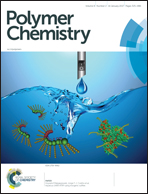Synthesis and self-assembly of diblock glycopolypeptide analogues PMAgala-b-PBLG as multifunctional biomaterials for protein recognition, drug delivery and hepatoma cell targeting†
Abstract
A series of diblock amphiphilic glycopolypeptide analogues poly(6-O-methacryloyl-D-galactopyranose)-SS-poly(γ-benzyl-L-glutamate) (PMAgala-SS-PBLG) with well-defined and tunable structure, and redox-responsive disulfide linkage were prepared through a combination of modulated reactions including RAFT polymerization, ring-opening polymerization, “click” coupling reaction and following TFA-mediated deprotection, and a non-disulfide analogue PMAgala27-CC-PBLG30 was prepared as a control. Molecular structures of the above prepared PMAgala-b-PBLG glycopolypeptide analogues were further characterized and their self-assembly properties were examined. The glycopolypeptide analogues were able to form stabilized micelles (with α-helix PBLG cores) and the uniform-sized PMAgala-SS-PBLG micelles exhibited obvious redox-responsive features in the presence of glutathione (GSH), whereas the non-disulfide control did not show such change. For biological applications, the lectin recognition properties, doxorubicin (DOX) delivery manner and human hepatoma cell receptor targeting capabilities were further evaluated. The results illustrated that the PMAgala-b-PBLG glycopolypeptide analogues might serve as redox-responsive, highly biocompatible multifunctional biomaterial platforms for practical applications.


 Please wait while we load your content...
Please wait while we load your content...